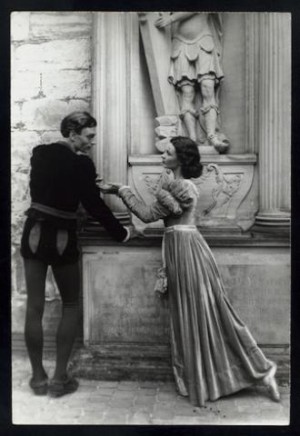
"Silent amateur film shot by John V. Hansen, engineer and member of the Amateur Cinema League, of a performance of Tyrone Guthrie’s Hamlet at Kronberg Castle, Elsinore, Denmark with Laurence Olivier as Hamlet. The first title card states that ‘the oldest metropolitan daily Berlingske Tidende of Copenhagen presents the Old Vic at Kronberg’. The second title states ‘snappy colour-shots from different angles of Scenes from Shakespeare’s ‘Hamlet’'. Film shows audience, cast getting ready and shots taken throughout the play" The Human Studies Film Archive via the British Universities and Film Council.
"George Merz's cine visit to Europe has captured the old world charm from Holland to Monaco via Belgium, Germany, Bavaria, Austria, Switzerland, an Italy. There is countryside, cities, waterways, architecture, arts, crafts, ruins, and parades reminiscent of the traditions of centuries. A good coverage of so large an area in thirty minutes" PSA Journal, Nov. 1958, 47.
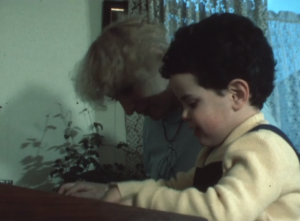
Después de una noche de tragos en un bar, Olga sale con un extraño y lo lleva a su hogar. Mientras tienen relaciones sexuales, ella ve la foto de un niño pequeño en la pared, y recuerda tocar el piano y divertirse con el. Después el filme muestra a Olga en el baño inyectándose drogas para después vagar por las calles bajo la influencia de narcóticos y alimentar a un perro con pan mientras continúa recordando estar con el pequeño niño. Olga regresa al mismo bar acompañada de una mujer y se emborracha; después de salir juntas hacia el hogar de Olga, empiezan a desvestirse y besarse. Olga ve la foto otra vez y empieza a llorar, esta escena es seguida por imágenes de ella recibiendo oxígeno en una ambulancia y después llorando a lado de la otra mujer, mirando la fotografía.
After a night of drinks in a bar, Olga leaves with a stranger and takes him home. While having sex with him, she sees the picture of a little boy on the wall, and remembers playing piano and having fun with him. Afterwards the film shows Olga in the bathroom injecting herself with drugs, wandering the streets while in the influence of the drugs and feeding a dog with bread while she keeps on remembering being with the kid. Olga then goes to the same bar with a woman and gets drunk, they leave together to Olga’s home and while they begin to undress and kiss, she sees the picture again and starts crying, this scene is followed by images of her receiving oxygen in an ambulance, and then crying again next to the other woman, looking at the picture.
"documentario"/documentary
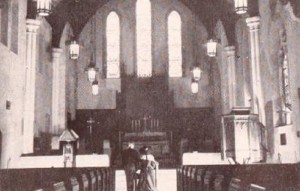
David Bradley's amateur feature film adaptation of Charles Dickens's Oliver Twist.
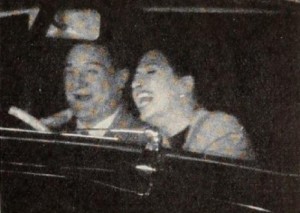
"Featuring a philandering wife, an illicit lover and a trusting husband, Olvido (Oblivion) proves once again, in the course of its sharply paced sequences, that the wages of sin is death. In it, the taut situations (which will lead at the last to murder and suicide) are so expertly directed and suavely acted that they develop always within the bounds of credibility. This achievement is especially noteworthy in an amateur photoplay of this melodramatic type. For others, attempting work in the same medium, have lapsed all too often into either the ridiculous or the farcical. Producers Oscar J. Bonello and Roberto Robertie, both officers of the Cine Club Argentino, in Buenos Aires, have used black and white film wisely, since its stark contrasts under low-key lighting are more effective than would be those of color. The Spanish sound track, employed sparingly and with dramatic force, is in keeping with the high standards of the rest of the picture." Movie Makers, Dec. 1952, 339.
Olympionic is another successful film by Rose and Stuart Dabbs of the Bronx. Naturally it's in color, and it is only 4 minutes long. The film is an excellent example of creativity, experimentation and what have you. It's all put together neatly. Here's your chance to see a film twice, three times and even as many as twenty times all in one screening. The gracefulness of the film is really a work of art. Oh yes, it's about Olympic diving" PSA Journal, Nov. 1969, 57.
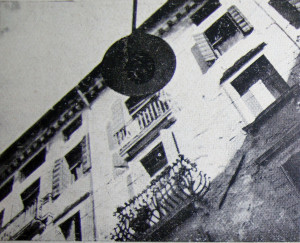
"doc. a fantasia"/avant-garde documentary
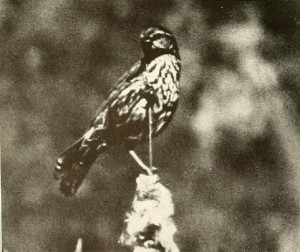
"On Every Hand, filmed by William L. Zeller, is one of those pictures, not infrequently found in the Ten Best selections, that make one marvel at the producer's infinite patience and deep knowledge of a special field. This is a study of those birds that can be found on every hand in the countryside and in the fields of America but which the average man fails to recognize, or even see, much less lovingly study as does Mr. Zeller. In this finished picture, there are many closeups made in the open of birds and their nests, which represent such a colorful variety of bird life as to give one something of a feeling of awe for the patience that Mr. Zeller must have exercised to catch the scenes. The picture is all in color, which brings a revelation of its own, and the continuity and titles are contrived to make an essentially record picture into good entertainment. For this quality, credit goes chiefly to the extremely well written titles and the editing." Movie Makers, Dec. 1936, 542.
Total Pages: 299